
A Functional IT Framework
Learn how people are re-envisioning the functions, processes, and best practices for infrastructure, development, security, and data in their organizations.
A t the beginning of a new decade, these lines from the play Inherit the Wind seem as appropriate for the technology industry as they did for the debate over evolution taking place in the drama. The tech industry is faced with a tricky balancing act: continuing to drive innovative solutions while grappling with the side effects of those solutions in the global economy. The challenge itself is not unique—every industry deals with this tension as it becomes more mature—but the new variables here are the scale that tech is able to achieve and the evolutionary aspect of mixing digital and physical worlds.
It's time for the industry to take the next step. There are tremendous benefits available through technology for both business and society, but there are major questions around safety, privacy, sustainability, and trust. The answers to these questions come from combining technical expertise with social awareness. By embracing responsibility for all the changes innovation can bring, the tech industry can be responsible for driving future progress.
Thanks to the vast influx of user-friendly technologies, it has become popular to say that every company is a tech company. But the ubiquity of technology does not necessarily change the underlying business model. While digital transformation is creating new avenues for growth, companies are finding that they cannot simply slap tech labels on their products and practices and automatically reap benefits. On one end of the spectrum, this takes the shape of larger companies going public and struggling with the realities of their industry. There are well-established economics and regulations in industries such as transportation or real estate. Software and mobile devices may connect consumers directly or change a distribution model, but it is more difficult to alter profit margins or navigate complex interconnections, especially at scale. On the other end of the spectrum, there are smaller businesses who can easily fall prey to marketing hyperbole. As with previous trends like unified communications or gamification, new trends like artificial intelligence and blockchain hold a great deal of promise but require significant investment or change to workflow. Smaller companies are finding that purchasing new technology is not the same as truly integrating that technology for improved results. Just as the opportunistic use of labels has often applied to individual trends, the same behavior has been happening with technology in general. Rather than attempting to use technology as a crutch, businesses will become much more intentional about strategically integrating technology into their culture and roadmap.
Workforce diversity most often refers to having an employee population that reflects the general population, with no preferential treatment or restrictive measure given on the basis of gender, race, age, or other factors. The technology workforce in particular has been under the microscope for its lack of diversity thanks to unconscious bias and optimization along with other behavior that is far more conscious, such as barriers to access for low income students or even reports of outright abuse. In 2020, the call for improved diversity will continue to pay dividends, even if fully diverse and inclusive environments still lie further in the future. Going beyond efforts around common conceptions of diversity, there will also be a marked increase in the skill diversity that companies are seeking. Twenty years ago, the stereotypical IT worker had a heavy concentration in infrastructure skills and worked in relative isolation from the rest of the business. Today, companies are seeking expertise across all four areas of CompTIA’s IT framework—infrastructure, software development, cybersecurity, and data. In many cases, companies are hoping to find candidates with some degree of work experience, so there is less willingness to take an entry-level generalist and steer them towards a specialization. Beyond technical skills, businesses are also looking for technology professionals that can speak the language of the business, collaborating with other departments in order to drive technology-fueled business results. Employability skills such as communications and teamwork are no longer reserved for those workers on a management track, but now apply at every level. Given the shortage of skills on the market, there are no easy answers for how companies will fill these needs, but there are tremendous opportunities for technologists in every field.
As the IT industry is maturing, there are challenges posed as a result of tech’s larger impact on the economy and deeper integration with society. In 2020, the U.S. election cycle will put a spotlight on many of these issues. Debate in Washington and around the country has already begun with respect to the responsibilities of certain players in the IT sector. Despite the overwhelming consumer and business benefits enabled by the IT industry, CompTIA data shows that 7 in 10 firms in the business of selling technology, most SMB-sized, fear that a negative perception of the tech industry is gaining momentum across the country and becoming more of an issue in general. In particular, increased awareness over privacy and how information is being collected and used could impact voters’ decisions. Other issues might also join the discussion this election cycle, including cybersecurity, automation, artificial intelligence, net neutrality, and technology’s role in mitigating climate change and educating our children. When it comes to voting itself, election security also remains a key concern for voters. The use of voting technology, coupled with the need to assure voters that their ballot will be counted, underscores the need for safety, reliability, and accessibility in digital infrastructure.
Over the past several years, there has been a lot of excitement around emerging technologies. At an operational level, this has been a positive trend as it has helped businesses build better practices for evaluating early-stage topics and accelerating adoption. At a tactical level, though, it has created some chaos. Without the chance to wait and see which technologies prove their worth, companies have found themselves confronted with a bevy of options—a situation that exacerbates resource constraint and skill gaps. Heading into a new year, the hype around emerging technology remains high, especially among those firms selling and supporting technology. Many firms in the IT industry are expecting significant gains in emerging tech adoption or growth within their user base. Of course, part of the reason for significant gains is that the original base is fairly small. And this is where the reality sets in. CompTIA’s end user data shows a very slow adoption curve across various new trends, with only two trends beginning to reach critical mass (internet of things and artificial intelligence). Even amid all the hype, companies in the business of technology are starting to pull back on adopting new technology as part of their portfolio. This slight tap on the brakes suggests that classic situation where companies move too quickly into a new technology discipline or business model only to have a reality check in year two or three. Beyond IoT and AI, companies are excited about building solutions on top of 5G infrastructure, and other topics may have strong but specific use cases (drones), function more as enabling technology (blockchain), or still have years before making an impact (quantum computing). The market is settling down, but it will remain a source of interest since new trends can still take off overnight.
As one of the two emerging technologies to be gaining significant traction, internet of things seems poised to join cloud computing and mobile devices as a permanent part of the modern technology landscape. Businesses are quickly discovering the value in digitizing their environment and their operations, collecting data that can help with future decision-making. The trend is also showing positive returns for companies that sell and support technology. Half of these firms report either major or minor levels of IoT-related sales in the last year, with others experimenting internally. Today, IoT as a managed services play is driving the most revenue in this category, but looking ahead to the next two years companies are predicting that analytics on data captured by IoT sensors – then shared with customers – holds the most financial promise. The first wave of IoT adoption is making good progress, but the next stage will require a keen understanding of digital BizOps. Rather than treating IoT installations as separate projects, businesses will have to recognize that they are dealing with an expanded architecture. This will dictate networking structures, storage options, data policies, and security decisions. These changes will drive both channel firms and internal IT departments to invest in skills training in order to fully establish a successful data-based analytics practice. As with cloud computing and mobile devices, the groundwork has been laid for IoT to advance digital transformation.
When Marc Andreessen made his now-famous statement about software in 2011, he may not have even realized the extent to which the world would be consumed over the next decade. Cloud computing lowered both the barrier for developing software and the barrier for distribution, and mobile devices extended the reach of software to previously unreached corners. The net effect was an exponential increase in software’s ability to drive activity. This created a new challenge in conducting said activity and acting on the data being collected. Enter artificial intelligence. With a foundation of software-driven routines and the compute resources to broadly run advanced algorithms, AI can push software to the next level. However, there’s a fine line between “eating the world” and “global domination.” The challenges of programming bias and unreasonable outputs mean that AI requires a different form of oversight than earlier software models. This oversight is an example of the kind of responsible implementation that technology professionals and solution providers must now perform. In addition, functional AI is like any other software in that it requires solid inputs. In the case of AI, these inputs are often massive datasets rather than highly specific data points, but there is still a need to ensure quality. For all the disruptive power that AI holds for business operations and job roles, it opens new opportunities for those with the expertise to manage its appetite.
According to CompTIA’s Tech Buying Trends Among Small & Medium-Sized Businesses, the top technology area where SMBs need the most work is integrating various platforms, applications, and data. Large businesses are focused on integration as well, but they have more internal resources that they can lean on. Even so, third parties are a popular option for integration activities, especially where deep knowledge is needed for a particular platform or application. Whether integration is outsourced or being done in-house, the next step for many businesses will be automation. Automation has always been one goal of enterprise technology, but today’s capabilities open new doors. Just by using cloud systems, companies can take advantage of tools from their cloud provider. Internet of things implementations expand the ability to gather inputs from a variety of sources, and artificial intelligence can help drive actions based on those inputs. From there, the vast array of other emerging technologies allows companies to imagine and build complex automation. The goal of this automation, as with all technological advances, is to reduce the amount of routine work and to create breathing room for innovation. There will certainly be job roles that are disrupted in the process, but throughout the decade businesses have shown a preference for keeping and repurposing skilled workers in an environment of skill shortages. Future automation will be highly complex, and the nature of AI will necessitate some amount of monitoring, so the endeavor will not be cheap. As with all strategic IT, businesses will need to see clear ROI calculations and long-term improvement plans before venturing deeper into automation.
The theme of cybersecurity over the past decade was a shift from a purely defensive mindset to a proactive approach that combined technology, process, and education. Moving forward, the shift will be from cybersecurity as a component of IT to cybersecurity as a critical business function. When treated as part of IT, a proactive approach to cybersecurity may still struggle to get the proper budget allocation or properly demonstrate value to the business. As a result, organizations are beginning to treat cybersecurity as a dedicated function. At large enterprises, this usually takes the form of a CISO managing a team of resources, and the division is more clear. For everyone else, establishing a cybersecurity center of operations is much less formal and involves a blend of internal and external resources. The process starts with defining risk tolerance, a step that most companies are not familiar with after simply placing all corporate content behind a secure perimeter. The next step is to fill the skill gaps that exist, which has become a difficult task with so many different areas under the umbrella of security. Finally, there must be metrics to measure the return on a more significant investment. Separating cybersecurity from IT and taking these steps elevates the function to that of a critical business operation, on par with legal or accounting. For third parties providing security services and technical employees with security responsibilities, the transition will not take place overnight, but there will be notable progress throughout the year.
Deep fake applications are genuinely terrifying. We are talking about video and voice forgery software that convincingly makes people appear to be doing and saying things they are not. This has the potential to wreak havoc on society, personal lives, politics, careers, and beyond. And while such trickery might seem like a fun distraction or the latest internet game, using these apps also means handing over reams of personal information to strangers. Scary, right? As long as deep fake applications exist – and they will continue to exist and proliferate – the need for sophisticated data management will skyrocket in the coming years. And data volume, already completely exponential, is only going to mushroom with the more expansive rollout of 5G networks next year and beyond. This high-speed network is going to capture data at lightning-fast pace from any type of device or inanimate object. In the next year, these two trends are just the primary examples of ongoing issues with data management. The need to properly identify that data with its true source (i.e. a deep fake verification) and to secure the mountains of information speeding along these networks is going to be paramount for both major broadband providers and their downstream partners in the channel, as well as individual IT departments, and possibly the government.
“It was the best of times, it was the worst of times.” Dickens could very well be speaking about the state of today’s technology industry. The stock market has been flying high for the most part. The top five corporations in terms of global market capitalization sport names like Microsoft, Apple, Amazon, Google, and Facebook. Emerging technologies offer exciting promise. And yet, it is also a time of uncertainty. Issues related to privacy violations, data protection, election interference, and others have thrust the industry, and many of its leading corporations, into the media spotlight and the government’s watchdog lens. For many who work in technology, the potential for increased government regulation, which some states are already pursuing, is an obvious concern. Most IT firms are operating on slim margins with limited cash flow. They fear too much regulation could restrain growth, while deregulation, they argue, could spur it. In fact, based on CompTIA’s 8th State of the Channel research, government regulation of the tech industry tops the worry list for the coming year, while a potential downturn to current economic conditions also sparks anxiety. That’s a significant shift from last year when the main concerns for future success focused on new types of competitors in the market and a skills gap for emerging technologies. Those are still valid business concerns, but it’s clear that on a macro level, people are waking up to the fact that the Wild West days are over as the tech industry matures and grows more complex. Success and advancement come with a price: balancing demands for more accountability while continuing to innovate. The question ahead is how the tech industry takes ownership of these issues and works with government to build the proper set of guidelines.
The global information technology industry is on pace to reach $5.2 trillion in 2020, according to the research consultancy IDC. The enormity of the industry is a function of many of the trends discussed in this report. Economies, jobs, and personal lives are becoming more digital, more connected, and more automated. Waves of innovation build over time, powering the technology growth engine that appears to be on the cusp of another major step forward.
The United States is the largest tech market in the world, representing 32% of the total, or approximately $1.7 trillion for 2020. In the U.S., as well as in many other countries, the tech sector accounts for a significant portion of economic activity. CompTIA’s Cyberstates report reveals that the economic impact of the U.S. tech sector, measured as a percentage of gross domestic product, exceeds that of most other industries, including notable sectors such as retail, construction, and transportation.
Despite the size of the U.S. market, the majority of technology spending (68%) occurs beyond its borders. Spending is often correlated with factors such as population, GDP, and market maturity.
Among global regions, western Europe remains a significant contributor, accounting for approximately one of every five technology dollars spent worldwide. However, as far as individual countries go, China has clearly established itself as a major player in the global tech market. China has followed a pattern that can also be seen in developing regions, where there is a twofold effect of closing the gap in categories such as IT infrastructure, software, and services, along with staking out leadership positions in emerging areas such as robotics.
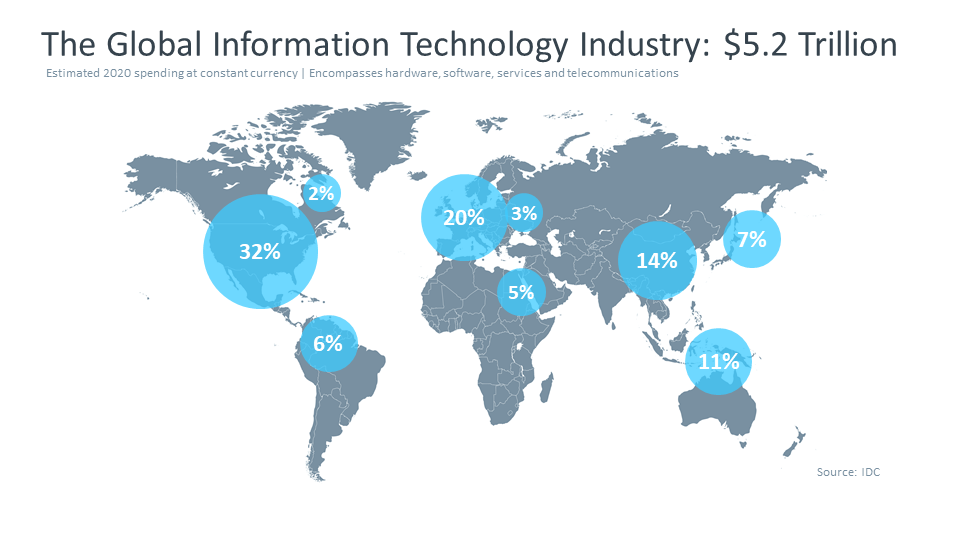
The bulk of technology spending stems from purchases made by corporate or government entities. A smaller portion comes from household spending, including home-based businesses. With the blurring of work and personal life, especially in the small business space, along with the shadow IT phenomenon, it can be difficult to precisely classify certain types of technology purchases as being solely business or solely consumer.
CompTIA projects the global information technology industry will grow at a rate of 3.7% in 2020. The optimistic upside forecast is in the 5.4% range, with a downside floor of 1.9%. Growth expectations for the U.S. market are in line with the global projection. As the largest tech market in the world, U.S. forecasts and global forecasts are inextricably linked. This is a narrower forecast range than what has been seen in past years, meaning industry executives are exercising a relatively high degree of caution in an unpredictable environment.
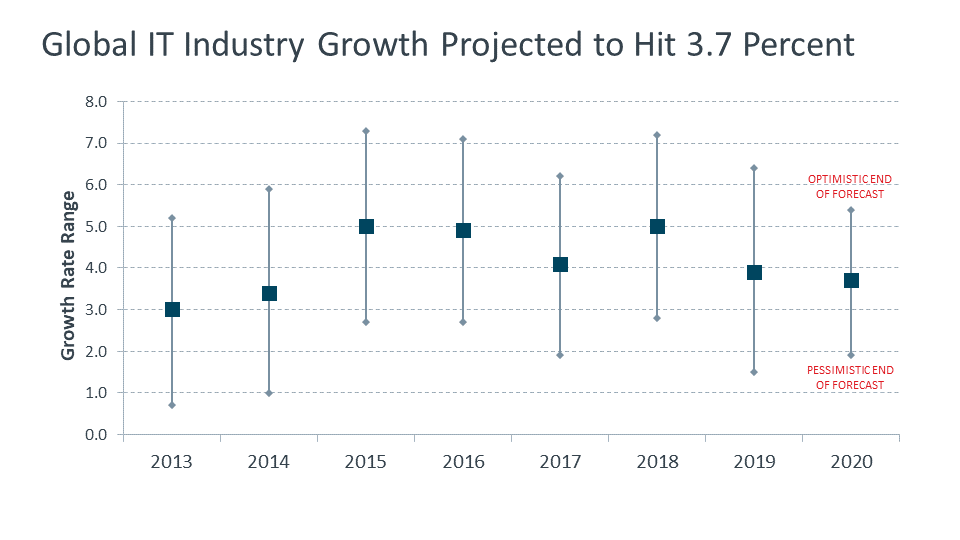
CompTIA uses a consensus forecasting approach. This “wisdom of the crowds” model attempts to balance the opinions of large IT firms with small IT firms, as well as optimistic opinions with pessimistic opinions. The results attempt a best-fit forecast that reflects the sentiment of industry executives.
As with any forecast, especially one as far-reaching as overall industry growth, many factors can play a role in the estimation. On the upside, spending on emerging tech may accelerate and even drive additional spending in well-established areas that act as foundational pieces. Conversely, currency fluctuations or trade policies could have a negative impact, causing companies to tighten their belt on discretionary IT purchases.
Other factors that influence revenue growth projections include pricing and product mix. The tech space is somewhat unique in that prices tend to fall over time, which may result in large numbers of units shipped but only modest revenue growth. As with last year, the product mix in the year ahead will be an especially important factor, as the high growth rates of emerging categories are expected to more than offset the slow growth mature categories.
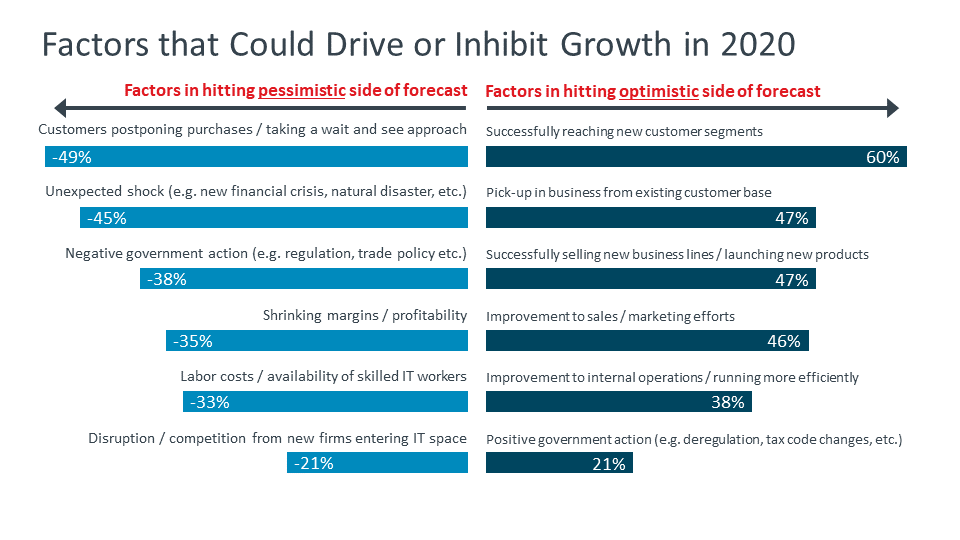
There are a number of taxonomies for depicting the information technology space. Using the conventional approach, the industry market can be categorized into five top level buckets. The traditional categories of hardware, software and services account for 56% of the global total. The other core category, telecom services, accounts for 26%. The remaining 17% covers various emerging technologies that either don’t fit into one of the traditional buckets or span multiple categories, which is the case for many emerging ‘as-a-service’ solutions that include elements of hardware, software, and service, such as IoT, drones, and many automating technologies.
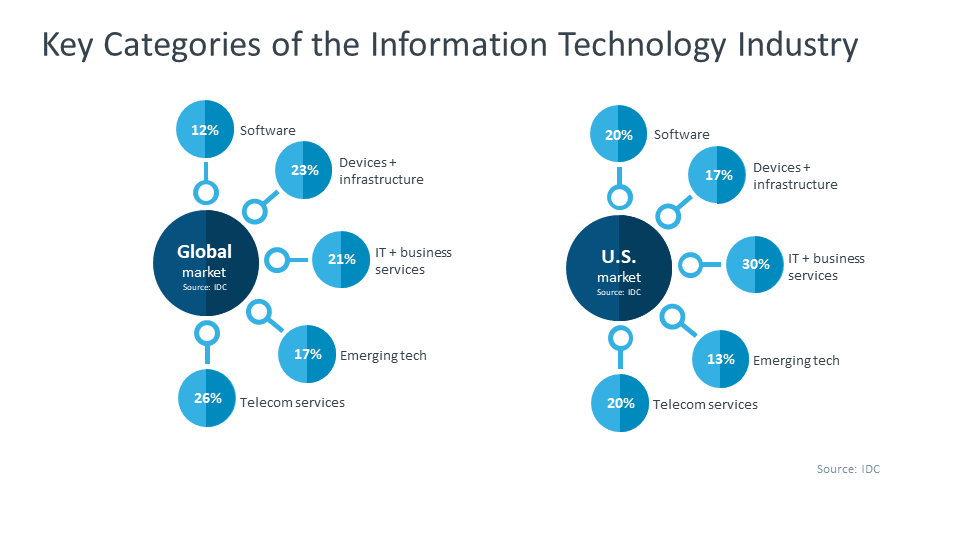
The allocation of spending will vary from country to country based on a number of factors. In the mature U.S. market, for example, there is robust infrastructure and platforms, a large installed base of users equipped with connected devices, and available bandwidth for these devices to communicate. This paves the way for investments in the software and services that sit on top of this foundation.
Tech services and software account for nearly half of spending in the U.S. technology market, significantly higher than the rate in many other global regions. Countries that are not quite as far along in these areas tend to allocate more spending to traditional hardware and telecom services. Building out infrastructure and developing a broad-based digital workforce does not happen overnight. Scenarios do exist, however, whereby those without legacy infrastructure – and the friction that often comes with transitioning from old to new – may find an easier path to jump directly to the latest generation of technologies.
While emerging technologies currently account for only 17% of the overall global revenue, they are expected to drive nearly half of the growth in new revenue. There are two caveats to this projection. First, the nature of emerging technology means that there is less history to guide future forecasts. Not only might the numbers be off, but it is also difficult to predict which categories will take off and which ones will fall by the wayside. Second, the stackable architecture of modern business systems blurs the lines between categories. While emerging technologies will be the driver for growth, they must be used in conjunction with more established technologies to create innovative solutions.
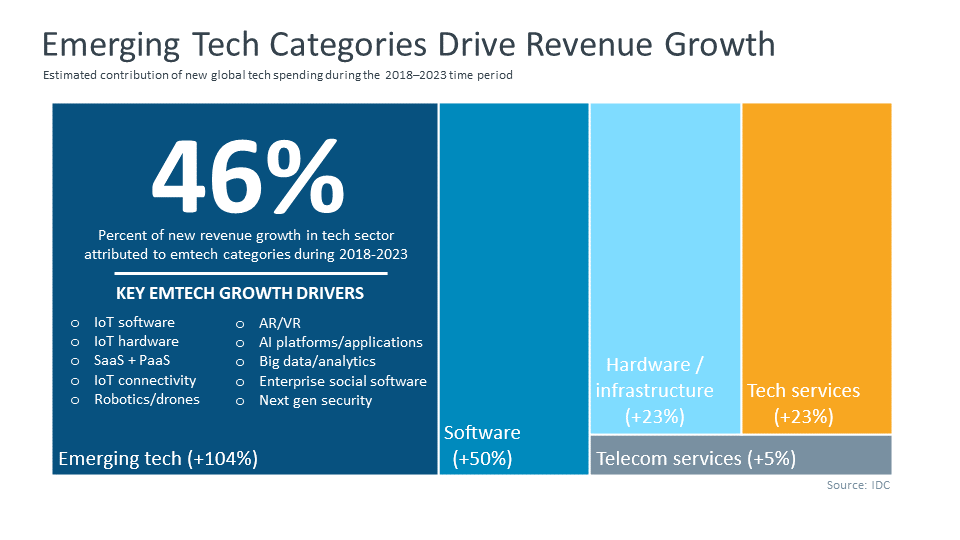
If the industry is strong and maturing, and if businesses are taking the next step in developing technology strategies, then it stands to reason that IT professionals should feel confident about their future prospects. Overall, this seems to be the case. The vast majority of technology workers feel optimistic about their role as an IT professional. In the U.S., 86% of IT pros rate their outlook as very good or fairly good. In different geographies, the sentiment is the same—81% in Canada, 75% in the UK, 82% in Australia/New Zealand (ANZ) and 85% in the Benelux region (Belgium/Netherlands/Luxembourg). The primary reason for the positive sentiment is high demand for technology skills, which in turn leads to robust career options. There is also a sense that the importance of technology to business objectives makes technology a more integral part of business operations and gives IT pros an opportunity to play a role in the direction of the organization.
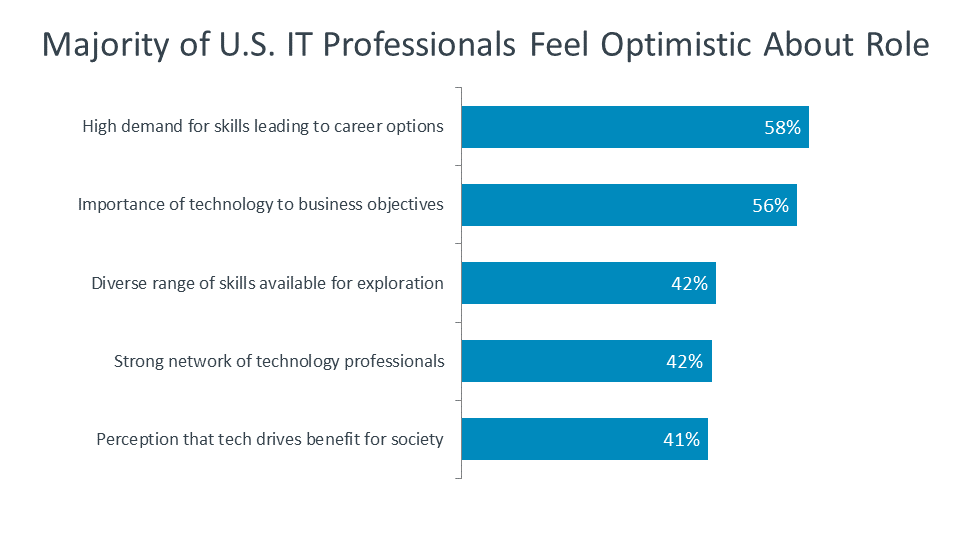
On the other hand, some individuals have reservations about their career in the technology field. One of the main reasons for concern is the challenge of increasing complexity in business systems. The trend of skill diversity is not lost on technology professionals. The first step in handling complexity is to grow individual skills, but as things scale up, it becomes untenable for one person to handle it all. This can lead to a feeling of uncertainty and also a feeling that better results are expected even though budgets are flat or shrinking. Other factors contribute as well. In the U.S. and Canada, there is slightly more worry over outsourcing. In the UK and ANZ, one of the main issues is an inability to pursue skill growth in the current role. And the Benelux region stands out in terms of fear over the perception that technology causes harm to society. To some degree, these issues are present for any field, and it is worth repeating that a minority of IT pros have any uneasiness at all.
The remainder of this report will focus on analysis of the U.S. market, and corresponding international data can be found in the supplemental material on CompTIA’s website.
In-demand skills are a major driver for future sentiment, but the reason skills are in such high demand is that there is such a wide variety today. As the trends section described, the IT skills of the previous era were marked by a heavy concentration in infrastructure. Now, as companies are maturing in their technology usage, there are demands across all four IT pillars defined by CompTIA’s IT framework. Software development is the area where most companies expect to place focus in the upcoming year, but there is also strong demand for cybersecurity, data, and infrastructure.
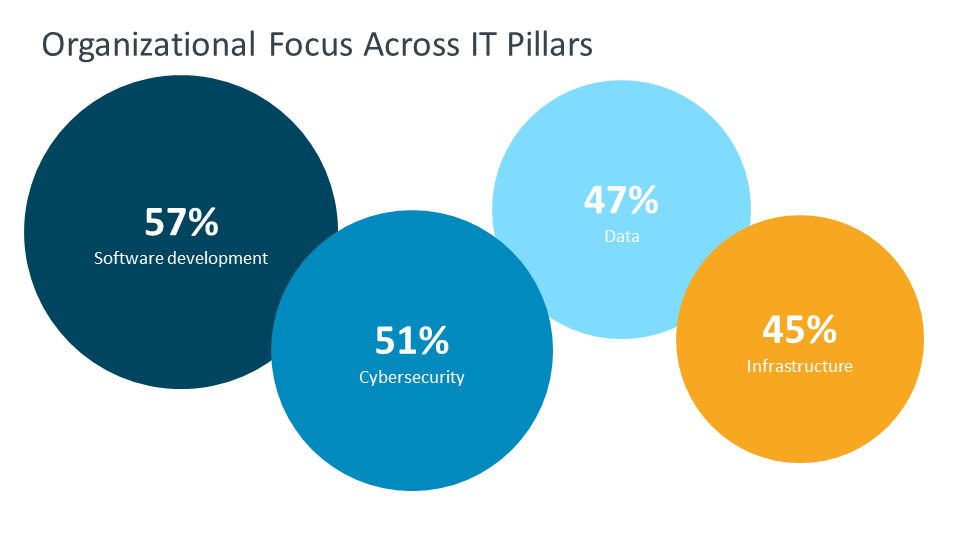
Looking at each area individually highlights the layers of complexity that companies are dealing with as they try to build the best skills within their workforce. Starting with infrastructure, the topic attracting the most attention in the upcoming year is cloud computing. Cloud computing is certainly not a driver of headlines today—indeed, it does not receive top billing in any of CompTIA’s 2020 trends—but it is still a driver of both IT tactics and IT strategy. As an established technology, companies are now in the next phase of cloud adoption, taking a holistic view of their IT architecture and reconfiguring workflow to take maximum advantage of cloud benefits. Other main concerns within the infrastructure category likewise have the feel of the tried and true. Networking is an area being constantly upgraded as data demands grow. Storage solutions need to match workflow demands, and solid backup plans are key for ongoing operations. Server administration is still a key role since very few companies are shifting to 100% cloud-based architecture. Only after these four areas are covered do companies begin thinking about an emerging topic with internet of things.
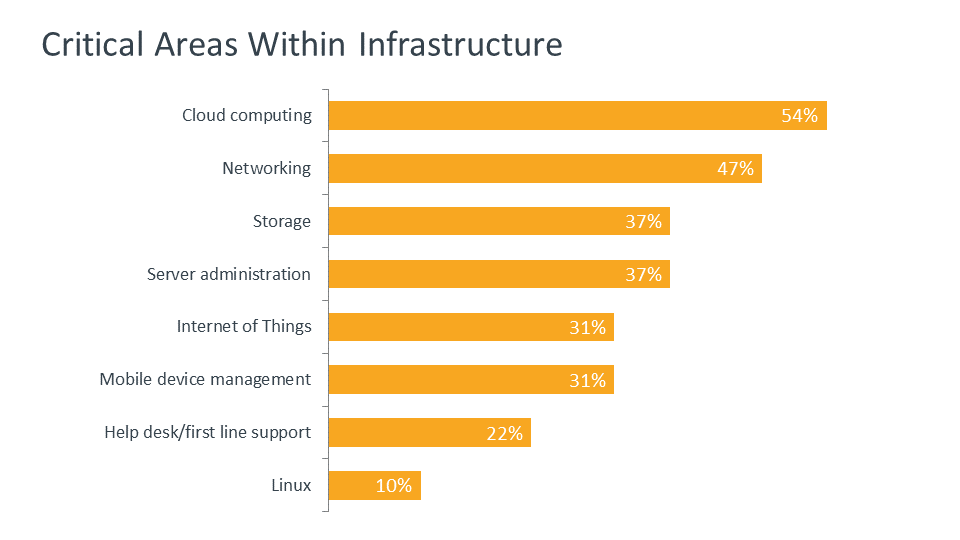
While software development is poised to be the primary pillar for many firms in 2020, it is also an area where many firms may not have a long history. Until cloud computing lowered barriers for custom development, companies relied heavily on packaged software. In order to come up to speed, businesses are quickly learning both the best practices of the past and the new evolutions in the development space. User experience is a good example of the latter, as mobile apps have redefined expectations around usability and reliability. Artificial intelligence is another evolution, albeit one in much earlier stages. Quality assurance is perhaps a topic that bridges both sides—a practice that has always been a part of software engineering, but one that has changed drastically as cloud computing has given rise to microservice architecture. For all the attention that DevOps has received, it is somewhat surprising to see it so low on the list of critical areas. This could be due to the fact that data and security are nearly on equal footing with development and infrastructure, so a practice revolving around only two of the four pillars is not comprehensive enough.
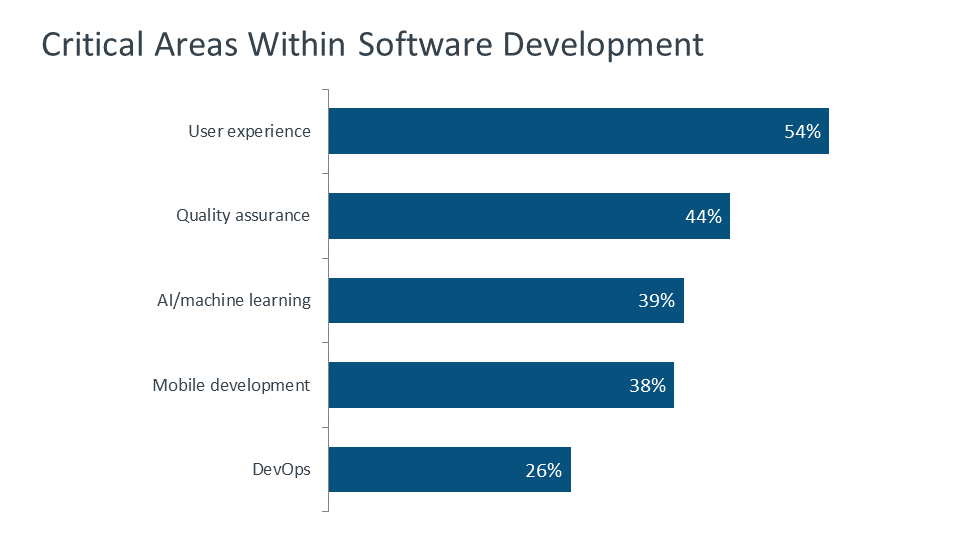
Cybersecurity is possibly the most complex of the four pillars, covering expanded defenses that companies must build, innovative approaches to proactively test those defenses, and internal processes that create secure operations. Cybersecurity analytics is the most prominent field companies plan to focus on, since the collection and analysis of data can help cut through some of the complexity and allow smaller teams to manage larger implementations. Privacy and risk analysis are less about technology tools and more about corporate policies, forcing companies to establish guidelines that may have never before been in place. The use of cybersecurity metrics may also be a new concept for some businesses, and IT pros must choose the best metrics to match their firm’s risk tolerance and business workflow. These areas are the most sought-after, but the reality is that all areas of cybersecurity are critical for building a robust security posture.
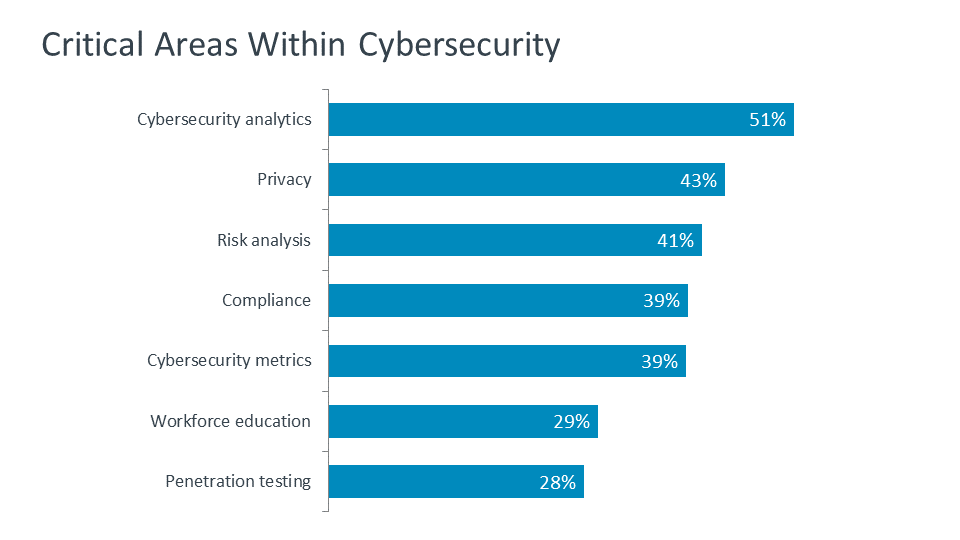
Finally, the field of data is not set up to be a dedicated function as often as cybersecurity, but it is still a field where businesses are trying to establish comprehensive policies and management. The leading two skills that companies are looking for demonstrate the typical balancing act between modern practices and established fundamentals. Predictive analytics has become the specific goal emerging from the general field of big data. Not every company is prepared to manage massive amounts of data being consolidated from multiple streams, but every company can begin using their existing data to produce insights. For those firms that are coming up to speed on data practices, database administration is a starting point for a more formal approach. As far as cutting edge technologies, distributed ledgers such as blockchain have tremendous potential, but there are still hurdles in implementation and the technology will most likely remain a degree separated from most end users.
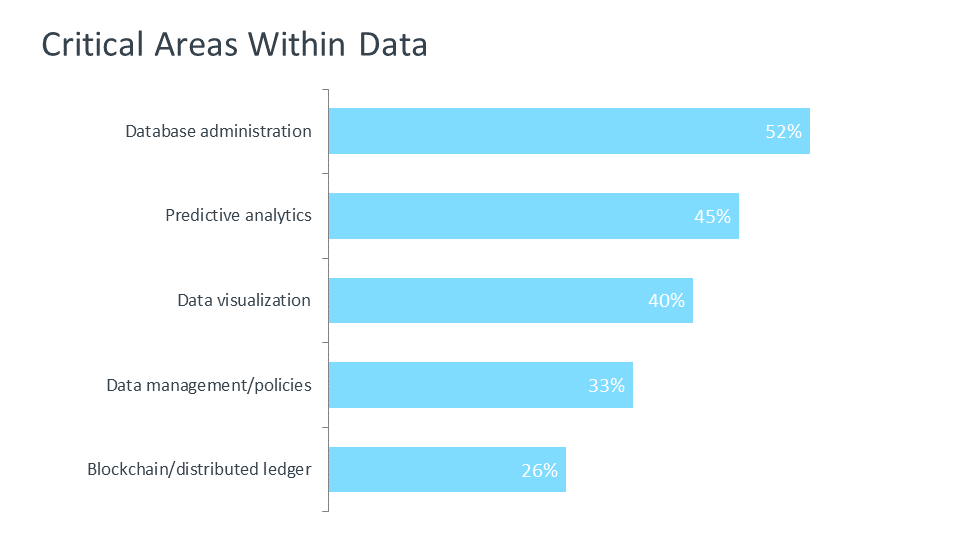
Adding to the challenge of filling a broad range of skills, companies are generally looking for candidates with deeper expertise. Across all four IT pillars, hiring companies are primarily targeting either early career (3-5 years of experience) or mid-level (6-10 years of experience). This may make sense in the areas of infrastructure and software development, where businesses have likely built a hierarchy of skills over time. For cybersecurity and data, the situation is more complicated. These areas, which have traditionally been subsets of infrastructure and development, have relied on those foundational pillars to provide the entry level skills. Now that they are distinct functions, there are difficulties in creating the pipeline for more advanced talent. Over time, entry level positions will likely emerge, but in the meantime companies will have to explore different avenues for filling their skill gaps.
Thanks to these pipeline challenges, hiring is lower on the priority list for companies in the upcoming year. Instead, there will be a strong focus on training and certifying the employees that are already on board. When it comes to career growth, there are three distinct areas IT pros expect to develop. First is technical skill within the existing specialization. With so many different topics within each pillar, there is plenty of room for growth. Second is technical skill in a new area. The four pillars interact in unique ways, and these overlaps define how business solutions are built and maintained. The final focus area for career growth is project management, going beyond the technical interactions to handle scheduling, deliverables, and tradeoffs.
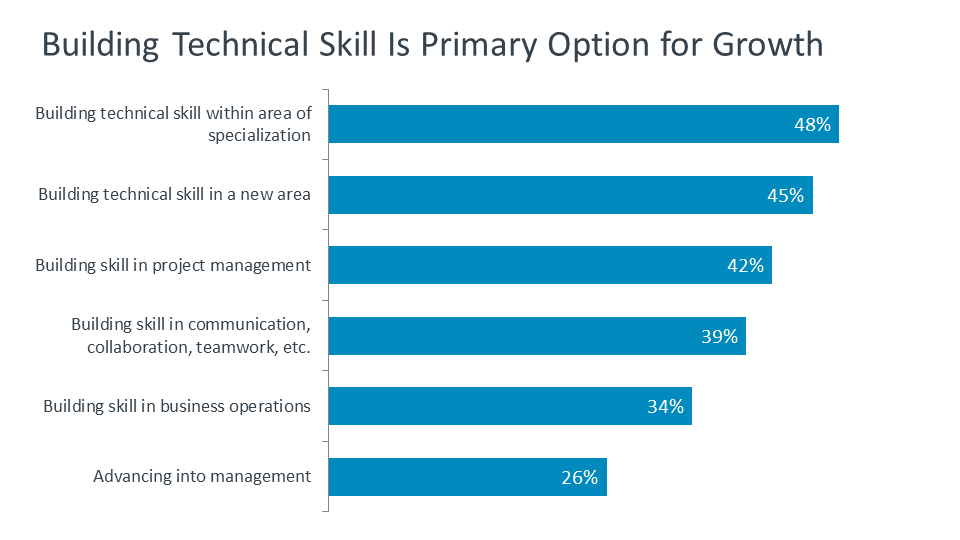
Shifting gears from skill needs and development, the other workforce topic that will be a major issue in the upcoming year is diversity and inclusion. Although 30% of companies feel that there has been significant improvement in the diversity of the tech workforce over the past two years, previous CompTIA research has shown that sentiment tends to skew more positive than reality on this topic. A wide range of research and anecdotal examples proves that there is still much work to do in achieving equity, from data on wage gaps to the makeup of executive teams to ongoing reports of abusive behavior. The trend may be heading in the right direction, but the chasm was so wide that it will take significant time and intentional changes to close.
Four out of 10 companies say that fostering workforce diversity is a high priority for 2020. There is a long list of actions that could improve the situation. Flexible work arrangements, including the physical environment, can create more opportunities and a more welcoming atmosphere, especially if there is a hard look at how the existing arrangements unintentionally create barriers. Training remains a popular option, though it is imperative that the principles from training are also found in corporate culture. Some options that may deserve broader adoption are recruiting from training programs that focus on underserved populations (which also has the effect of improving the skill gap problem) and carefully reviewing corporate communications to ensure equal representation and inclusive language.
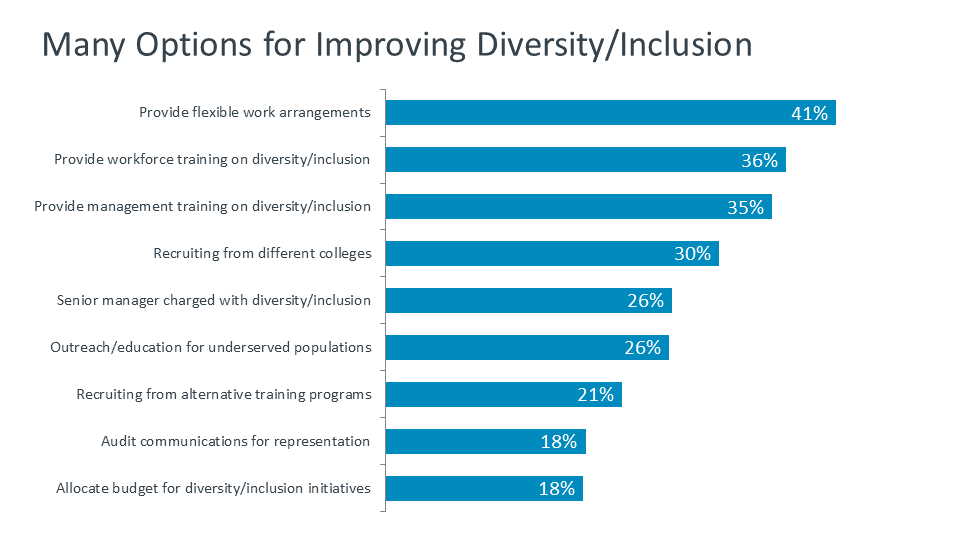
Overall, the landscape for the IT profession in 2020 is one full of opportunity but also one that is rapidly changing. There is the potential to apply technical skills across the business for personal exposure and growth, and there are also unique questions that need to be answered around the role of technology in modern business and society. As existing skills and practices provide the foundation for digital transformation, technologists should also be open to new skills and practices that add value to their business and produce success in their career.
Rapid change is happening across the IT channel today, affecting business models, the competitive landscape, customer types, buying patterns, M&A activity and more. Technology and the business of selling it has grown far more complex. What was once a fairly stable set of infrastructure products in a channel provider’s portfolio has, in the cloud age, morphed into myriad choices around software-as-a-service applications, data tools, and a stack of emerging technologies. It’s a far cry from straight-up hardware device sales. As a result of this complexity, integration work and security considerations have ratcheted up, making the channel’s job more and more challenging. But with challenges come opportunities. Looking ahead to 2020, firms that manage to thrive will be making investments in skills training, expanding their market reach to new customers and verticals, partnering with potential competitors, and embracing emerging tech. For many, that means getting out of their comfort zone.
Companies in the channel are pretty clear about what they believe will contribute to positive outcomes next year. It’s about the customer. Six in 10 channel firms said the No. 1 factor that will ensure robust growth for them will be their ability to reach new customer segments. This likely means both expanding into new vertical markets or simply growing the aggregate number of customers across the business. The No. 2 catalyst for a positive year includes picking up additional business from existing clients. This is especially true with managed services providers for whom upselling current customers to additional types or tiers of services is often the key to growing revenue and profit margin. Other areas where firms place value include expanding their business lines, which explains the enthusiasm seen for adding emerging technologies to their portfolios. From a practical perspective, companies also see potential benefit from tightening up their operations internally. Efficiency and cost-cutting, while not the most exciting, are a necessary measure to investing in new market expansion and new customer acquisition.
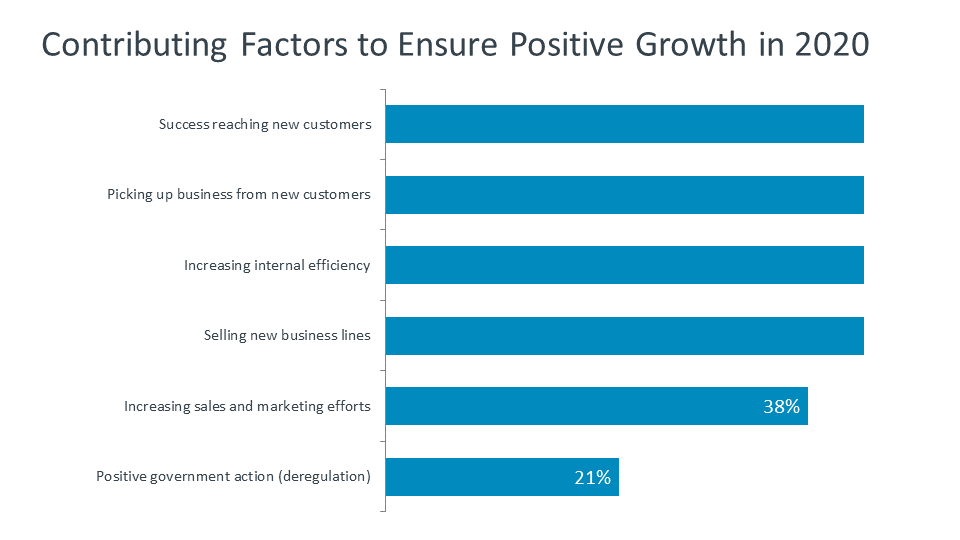
What could derail 2020? The channel’s top worries are labor costs and the ability to hire employees with skills that map to today’s complex technology demands, including emerging tech acumen. It’s an interesting conundrum: on the one hand, you need employees with sophisticated skills to succeed in the digital age, but on the other hand, such employees – if you find them – will likely sit at the higher end of the pay scale. And because most channel firms are SMBs with tight budgets, managing the desire for the best-skilled employees for the future against resource availability in the present is a very real problem. It’s not unlike today’s college admissions dilemma, where a student endeavors to get into the best school, then finds that best school is financially untenable to attend.
It should also be noted that it is a fraught time for the tech industry in general. Privacy violations, data breaches, social media-enabled election interference, and other controversies have thrust the industry, and many of its leading corporations, into the media spotlight and the government’s watchdog lens. For many companies in the channel, the potential downstream repercussions of negative industry perceptions are a concern. Half of executives in the business of technology believe that increased government regulation could result from a kind of “techlash” effect. Four in 10 believe greater scrutiny will come from customers themselves. And still more believe innovation could be stifled because tech companies will start to fear lawsuits or other pushback and tap the brakes on new initiatives.
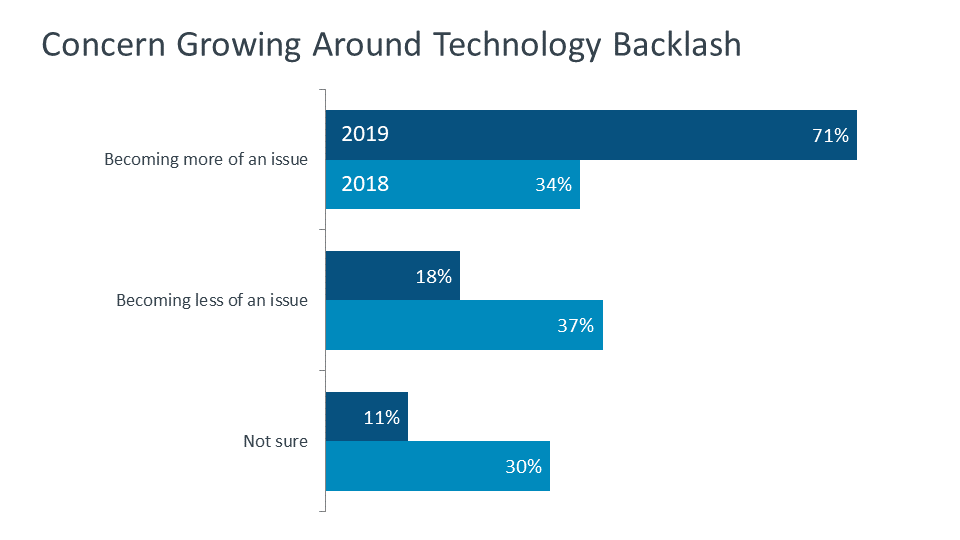
No discussion of the channel’s future should leave out the role of emerging technologies. Whether it’s blockchain, AI, VR, drones or IoT, these topics are capturing the channel’s attention in steadily growing numbers. But let’s be clear: adoption, as it has been on the end customer side, is mostly iterative, with more in-house experimentation at this point versus actual selling at scale. A channel firm that says it is selling some kind of artificial intelligence or virtual reality solution, for example, is most likely doing so with a limited number of customers and generating minimal revenue overall from these solutions. But that is the nature of the adoption of new technologies. It’s a process of research and vetting, followed by in-house experimentation, small-scale rollout, re-examination, then larger-scale rollout.
That said, there is no denying that enthusiasm is real among channel practitioners, who clearly see emerging tech as a means to cement future relevance in the industry and drive future sales. Asked if they could instantaneously gain expertise in a new technology area or a vertical industry specialty, 70% of channel firms chose a new technology area. This is despite years of talking about vertical specialization as a top competitive differentiator. Tech acumen about the next big thing matters to them. Looking ahead to 2020, half of channel organizations expect significant gains in emerging tech adoption. That includes both selling these wares in some capacity and experimenting with them in-house before deciding to add them to the official portfolio. Another 4 in 10 expect modest increases in their emerging tech adoption, while just 6% predict minor increases. The main catalysts for entering one or more of these markets are twofold. They represent a greater revenue opportunity than existing offerings and customer demand is starting to increase. Of course, customer demand should be viewed through a similar lens as the channel’s trajectory: high level of interest, cautious pace of adoption.
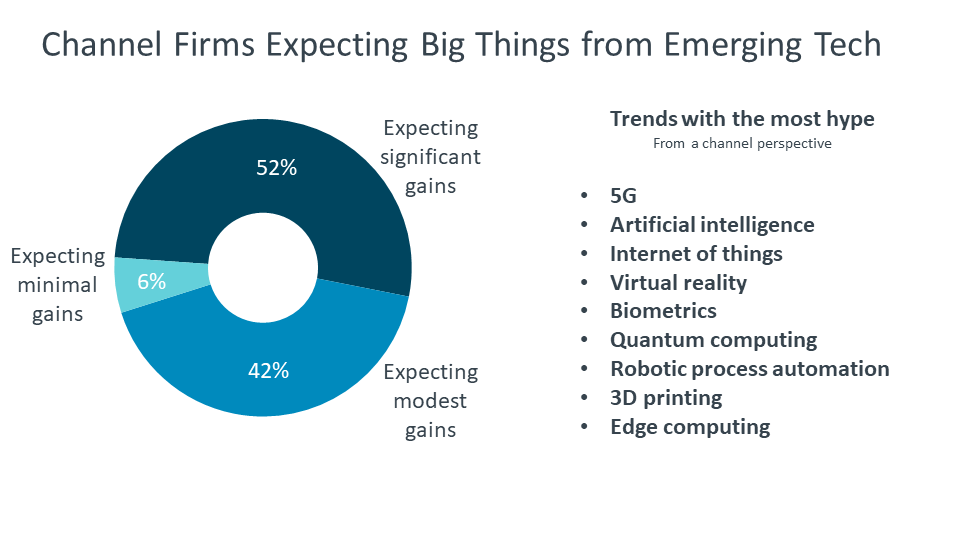
Of all the emerging tech categories – and they are myriad – IoT hardware and software ranked as the biggest revenue drivers, not surprising given their relative maturity compared to newer emerging tech categories such as drones, for example. 5G, AI, and VR may not have the current revenue stream, but channel firms are excited about the future potential of these fields. Items such as quantum computing or robotic process automation, while on the radar of a good portion of channel firms, are most likely not going to play a huge role in an organization’s revenue generation next year or beyond, other than for those in niche markets.
There are inhibitors to emerging tech adoption in the channel, and they make perfect sense given the general size and scope of most of these organizations. Budget constraints tie many a company’s hands even if they want to dive into a new solution category. Risk aversion is also real, while others struggle with determining a clear business need to adopt some of these new categories. One reason to throttle back on adoption exuberance? Customers. A quarter of channel firms say their customers are actually overwhelmed by the array of choices and the media bombardment about new, shiny stuff. As a result, they have decided to take it slow and focus more on the basics of their tech needs, such as security and infrastructure.
Increasing technology complexity has real-world implications for business models, that’s clear. But increasing technology ubiquity cannot be ignored. The democratization of technology across all levels of the business world is impacting how the channel sells and goes to market, to whom they sell, what the sales cycle looks like, and the type of services that wrap around any initial sale or engagement. More than half of channel professionals today (55%) say that IT budget ownership, at least in part, has shifted from solely the IT department to line of business groups, from the CFO’s office to human resources to marketing.
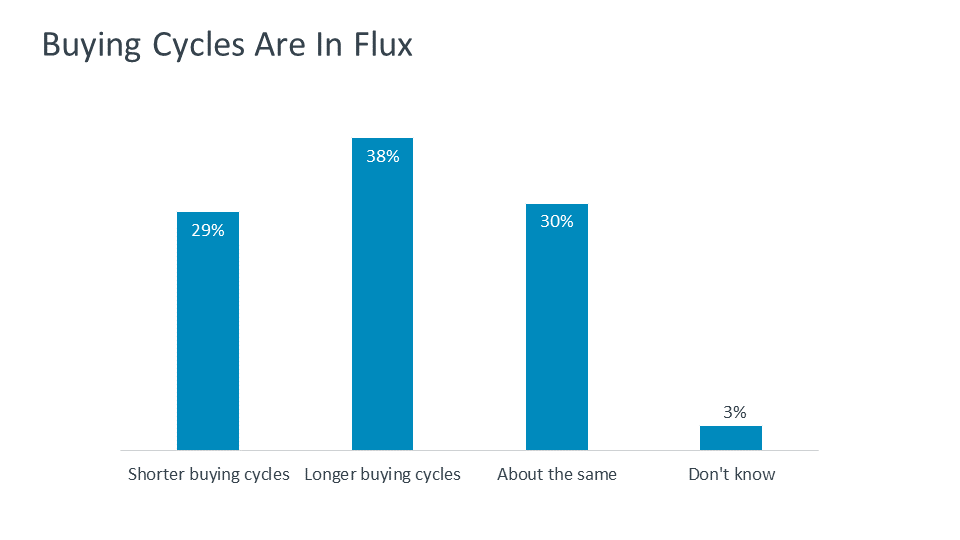
This has obviously been an upward trend for several years. But one of the more interesting consequences of this trend is somewhat longer sales cycles for many in the channel. Between increased technology complexity and the need to explain technology to a lay person versus the IT buyer, nearly 4 in 10 channel firms say the average sales cycle has gotten longer over the past year. Often, line of business buyers do not anticipate the many layers beyond the initial purchase, such as security, compliance, or integration services, that need to be factored into a decision. Once they are made aware, the time to finalize the engagement is lengthened.
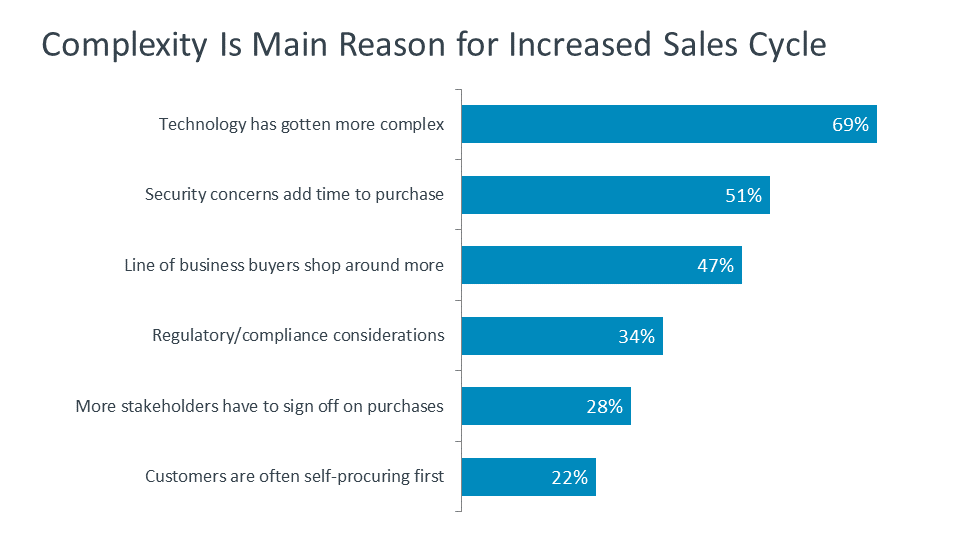
Along with managing their portfolio and their customer dynamics, workforce issues also loom large for channel firms today. Just 19% of companies say they are fully staffed at both technology- and business-related positions. Two-thirds of these firms have openings and are actively seeking to hire IT staff, while a third are looking to fill open positions on the business side of the house. Why so many open positions? Skills needs and desire to grow. A third of firms say that new skills needs, mainly to tackle emerging tech aspirations and other disciplines not previously practiced, have created a workforce crunch. Another third say they want to expand and grow their business, necessitating adding headcount.
A more-than-healthy economy of the last several years has resulted in a low unemployment rate and created an employees’ market – for now. That, coupled with the introduction of new technologies that require a more sophisticated level of skill, has spun up a bit of a perfect storm on the workforce front for the channel. Six in 10 channel firms say their hiring difficulties stem from having to compete heavily with other technology outfits for talent. Four in 10 are competing with organizations outside the tech industry for technology talent, which speaks to the widely held belief that every company today, regardless of industry, is a tech firm.
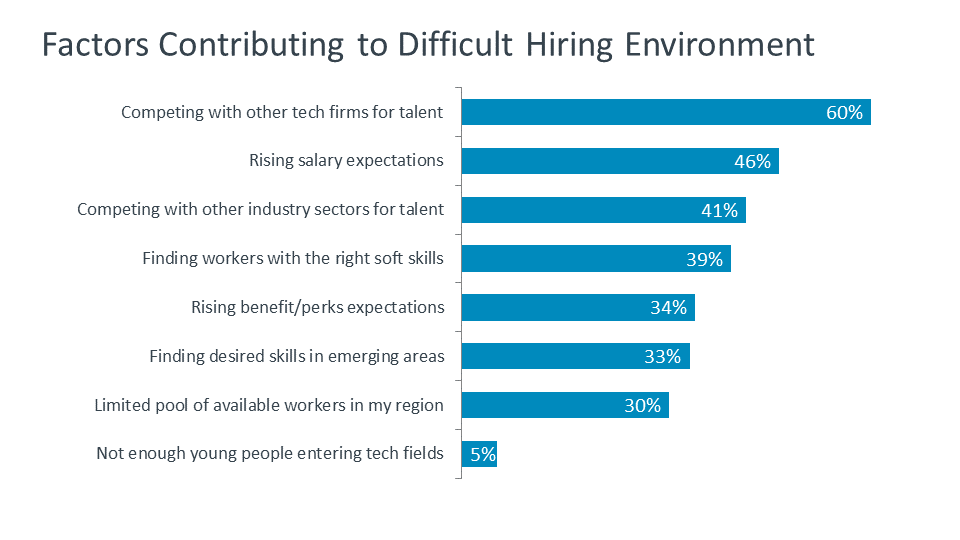
Additionally, channel firms today are making larger investments in marketing as they become more services-oriented in nature and rely less on hitching their brand to that of the vendors they sell. This is new territory for many smaller firms, in particular, that have never had devoted marketing headcount. Now they are looking.
And some are getting creative in how they hire by casting a wider net. For example, 3 in 10 channel firms of all sizes are eliminating a four-year college degree requirement for job candidates. That mirrors a trend that has been happening at the larger IT vendor level (think Google, Apple, or IBM) for some time now. Another 3 in 10 are filling positions with contract workers, while nearly 40% are hiring a full-time HR manager, something that has been mostly unheard of among the bulk of today’s channel based on their small size.
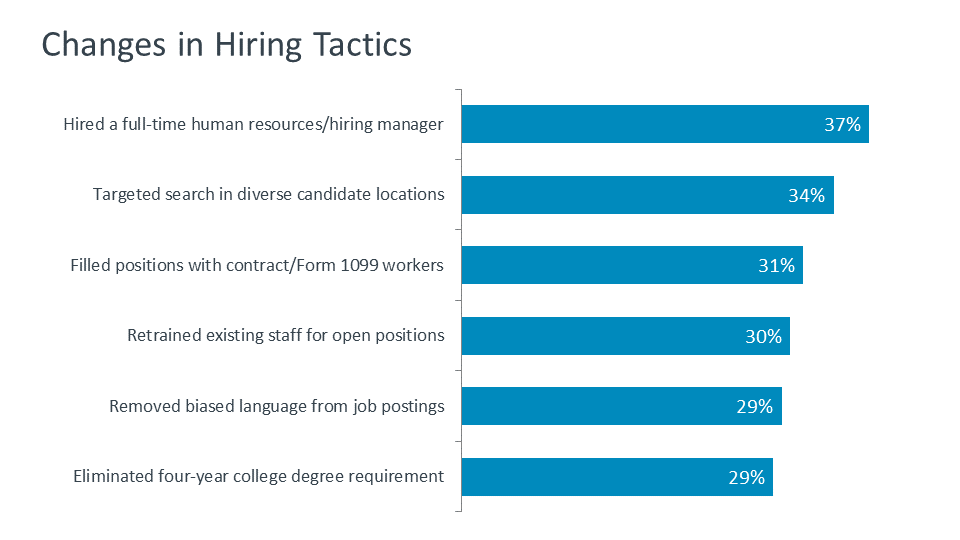
The Computing Technology Industry Association (CompTIA) is a leading voice and advocate for the $5.2 trillion global information technology ecosystem; and the more than 50 million industry and tech professionals who design, implement, manage, and safeguard the technology that powers the world’s economy. Through education, training, certifications, advocacy, philanthropy, and market research, CompTIA is the hub for advancing the tech industry and its workforce.
CompTIA’s IT Industry Outlook 2020 provides insight into the trends shaping the industry, its workforce, and its business models. Because trends do not occur in a vacuum, the report provides context through market sizing, workforce sizing, and other references to supporting data. The interrelated nature of technology – where elements of infrastructure, software, data and services come together, means trends tend to unfold in a step-like manner. A breakthrough may lead to a notable advance, which may then be followed by what could be perceived as lateral movement as the other inputs catch-up. Some of the trends highlighted in this report focus on an early stage facet of a trend, while others recognize a trend moving beyond “buzzword” to reaching a certain stage of market-ready maturity. As such, the timing of trend impact may vary from reader to reader depending on company type, role, or country. Lastly, if it appears a noteworthy technology, workforce, or business of technology trend is missing, it may be because the trend was covered in a previous release of the IT Industry Outlook. Visit www.CompTIA.org for past reports and an extensive library of research and educational content.
Read more about IT Workforce, The Business of Technology.